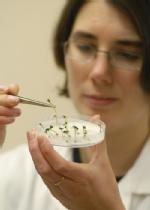The joy of seeds
When you plant a seed and green shoots rise from the earth, with this appearance of life comes a feeling of joy and hope, plus in many cases the promise of something very important: Food.
It is amazing that whole allotments, greenhouses and indeed fields full of vegetables and flowers can come from just a couple of handfuls of small, dry fragments. Dr Charlotte Allender, from Warwick’s Crop Centre, explains the importance, diversity and quite incredible resilience of seeds.
I see a lot of seeds throughout the year and they are beautiful and fascinating in equal measure. OK, disclaimer: I run the UK Vegetable Genebank which holds 14,000 seed samples of lots of different vegetable crops, so it is my job. But as many of us are spending unexpected time at home at the moment, others are taking a new interest gardening and horticulture. More and more people are giving vegetable growing a try, and while home grown is not an answer on a national level to replace full supermarket shelves, it is extremely satisfying on a personal level to see tiny seeds develop into mature and tasty plants.
The vegetable seed in the packets we buy is a marvel of biology and human ingenuity, all focused on delivering crisp carrots, crunchy cauliflower and other delicious crops. I was recently at a meeting where the author Simran Sethi described seeds as “stories which we consume”. If we think about it, they are a gift from the past to the future. They are the product not only of millions of years of evolution, but also the result of many centuries of human input, firstly by farmers and then more recently by specialist plant breeders.
So, what makes seeds so incredible?
Well, they are evolved to have two main jobs. The first is the production of the next generation of plants and they have a number of clever features and strategies to ensure this happens.

To help new plants to grow, seeds contain not only the beginning of the new plant itself (the embryo) but also an energy and nutrient store called the endosperm which supports the newly germinated seedling until it reaches the soil surface and can then make its own energy from the sun through photosynthesis. The endosperm is what makes seed nutritionally valuable for us - think wheat and other cereal crops, and also oil crops such as oilseed rape and sunflower oil. The endosperm is also vital to seed eating animals and birds.
Amazingly seeds also have the ability to sense the environment they are in and can delay germinating until conditions are just right to support the growth of delicate seedlings. This is called seed dormancy and is a very effective survival strategy particularly for wild plants – for example, seeds of many species won’t germinate unless they have experienced a period of cold temperature, which encourage growth in the spring rather than winter. When we sow seed of crop species we generally want them all to germinate and grow as soon as possible so in contrast, seed of most crops has very little, if any, dormancy.
A variety of shapes, sizes and designs
The second function of a seed is dispersal. This enables the new plants to grow in a new area rather than right on top of the parent plant which means they don’t compete for resources. This dispersal function means seeds come in an amazing variety of sizes and shapes to help them do this.

Most seeds have a tough outer layer to protect against water loss and damage. Some of them have hairs, spikes or wing-like parts to help with dispersal by hitching a ride on animal fur or getting caught on the wind. Carrot seed has hairs (normally cleaned off before packaging to stop them sticking together), lettuce seed has a little parachute made of fine hairs like that of a dandelion clock. Parsnip plants opt for a different approach where seeds have flat ‘wings’ to better catch the breeze. Obviously crop plants don’t have the same need for natural dispersal that wild species do, as seed producers and farmers do that job for them, but they still have some of these characteristics in common with their wild relatives.
Seeds are wonderful and fascinating and now is the ideal time of year to sow a few of your own. If you are out over the weekend planting some broccoli, lettuce, perhaps a sunflower, or if you are sowing a bit of cress on your window sill, have a proper look at the seed you are popping in the soil. It has taken thousands of years of evolution and breeding to perfect that little package. Seeds are little bundles of future potential, all wrapped up in a tough coat and I love working with them.
Published:
8 April 2020 - updated 22 September 2020
About:
 Dr Charlotte Allender manages the UK Vegetable Genebank at Warwick's Crop Centre, part of the School of Life Sciences.
Dr Charlotte Allender manages the UK Vegetable Genebank at Warwick's Crop Centre, part of the School of Life Sciences.
This year the UKVG celebrates its 40th anniversary.
The project conserves genetic diversity in important crop species and makes it available to researchers, plant breeders and growers in the UK and around the world.
Dr Allender's current research interests are genetic and genomic variation in carrots and related wild species and screening for novel traits in brassica crops.
Images:
Top: Pixabay
Middle: Wiki Commons
Bottom: Charlotte Allender/ UK Vegetable Gene Bank
Terms for republishing
The text in this article is licensed under a Creative Commons Attribution 4.0 International License (CC BY 4.0).
Share


